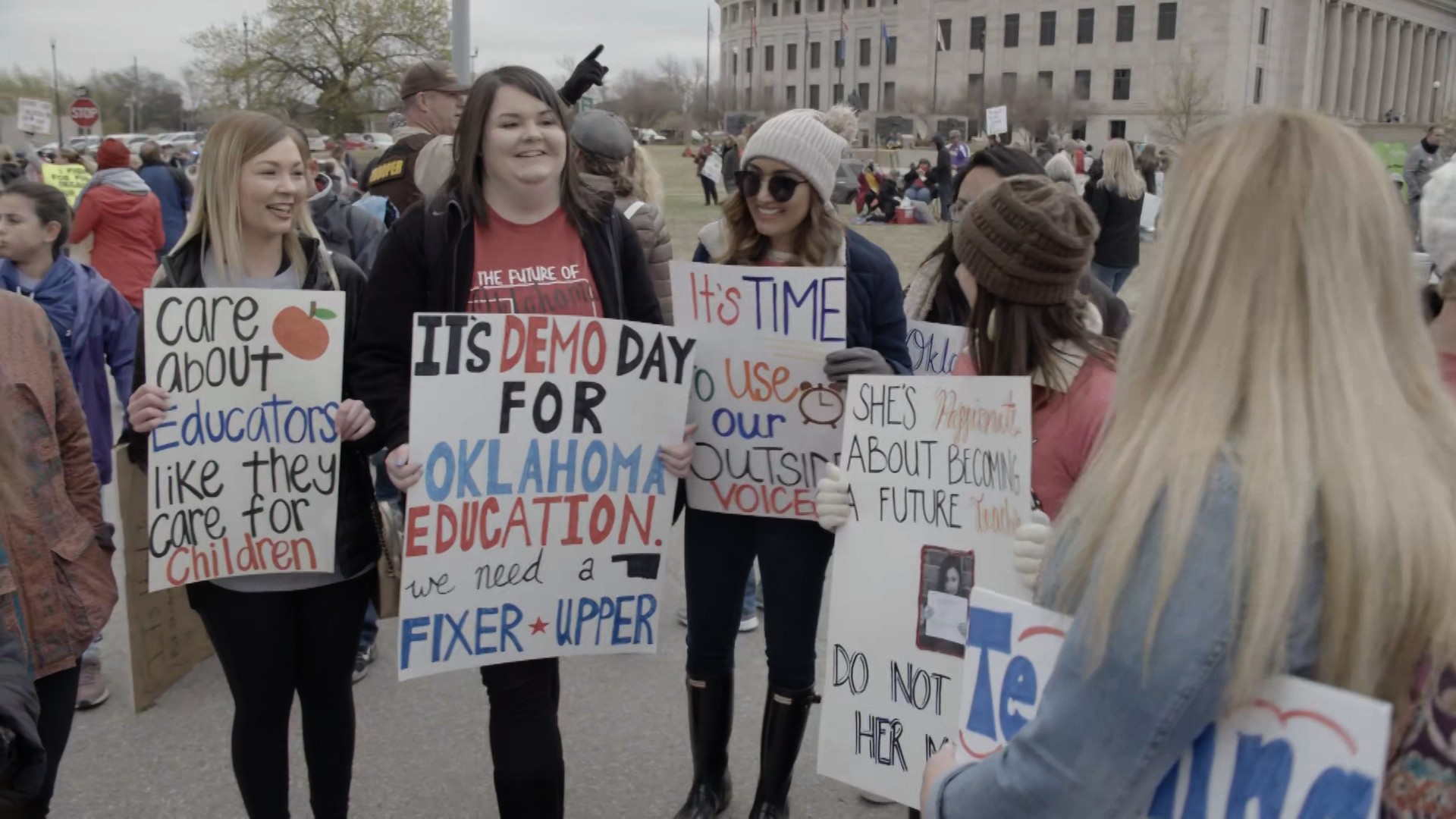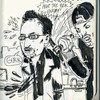These anti-right-wing protesters in Philadelphia are not representative of all Democrats. Photo by Cory Clark/NurPhoto via Getty
Former Starbucks CEO Howard Schultz's not-quite-official campaign for president is driven, he says, by a simple proposition: Donald Trump is too extreme, but Democrats have become too extreme in their own way. Elizabeth Warren's wealth tax, according to Schultz, is "ridiculous," while Medicare for all, endorsed by Warren and fellow Democratic 2020 candidate Kamala Harris, is "unaffordable."Though Schultz's remarks have gotten a lot of attention, he's hardly the first to make this kind of critique. Democrat Jerry Brown, who just ended his tenure as governor of California, said in December his own party was in danger of going too far left and supporting policies that are "harebrained schemes." Before the midterms, former Democratic president Jimmy Carter, who said he's voted for Bernie Sanders, cautioned Democrats they needed to appeal to independent voters to beat Trump. Mike Bloomberg, like Schultz a billionaire who may run for president as a centrist, said Warren's tax is probably unconstitutional. Conservative columnists in CNN and the Washington Examiner have offered Democrats the helpful advice that they are going too far left, citing policies endorsed by Warren, Harris, and living meme Congresswoman Alexandria Ocasio-Cortez. These are easy criticisms to make, but they reduce the Democratic Party to a caricature that ignores the party's still powerful moderate wing.The Democrats' transformation into a truly left-wing party is an easy story to tell, and there's some evidence for that story. Medicare for all—the idea that the government should be the provider of health insurance to all Americans—has gone from a relatively fringe position to one most potential 2020 contenders embrace. Some Democrats, like Ocasio-Cortez, are now calling for a "Green New Deal" that would guarantee government-funded jobs for everyone while transitioning the US economy away from heavy carbon emissions. Lots of prominent political figures are now willing to use left-wing rhetoric that would have sounded hopelessly utopian just a few years ago; some left-leaning young people are even comfortable calling themselves socialists. And this message gets amplified because many of these young leftists are, like Ocasio-Cortez, smart and funny on social media. If viral tweets won elections, private property would already be a thing of the past.This story of the Democrats' journey left is an attractive narrative for lots of different groups. Progressives like it because it shows that they've tugged the Democrats from being a truly centrist party in the 90s to one that's reflective of left-wing values—and they think a progressive party has a better chance of beating Trump anyway. Conservatives also like this story because it lets them paint Democrats as extremists. For the media, the rise of left-wing politicians is a new phenomenon to be reported on and debated (and debated, and debated, and debated).And it's true that the top-tier declared 2020 candidates are all progressives. Warren's entire career has been about fighting economic inequality, Harris has controversially stuck to her guns on Medicare for all, and Kirsten Gillibrand is possibly the most outspokenly feminist candidate of the cycle, having attracted a lot of attention for criticizing her fellow Democrat Al Franken when he was accused of sexual harassment. But all of them have obvious moderate streaks as well. Harris is running on her career as a prosecutor, to the anger of many on the left; Warren, unlike avowed socialists, has praise for capitalism, just not "capitalism without rules"; and when Gillibrand was asked on liberal podcast Pod Save America about ending the filibuster in the Senate—a necessary part of enacting any progressive agenda after 2020—she demurred:Digging into the Democrats' wave of victories in House elections last year, it's very difficult to sort out a cohesive narrative. Arguably, the center of the party has shifted to the left when it comes to issues like healthcare and the minimum wage, but a lot of non-radical Democrats got elected alongside lefty standard-bearers like Ocasio-Cortez and Rashida Tlaib.This week, in a piece about the place of centrists in the 2020 race, the New York Times noted a Pew survey finding that 53 percent of Democratic-leaning voters wanted the party to move in a more moderate direction. The Times also quoted a Bloomberg adviser who thinks that "there is a clear and sufficiently wide lane for a pragmatic candidate, and that the progressive lane is really crowded.”There are a few political heavyweights who could fill that lane. There's former Texas Senate candidate Beto O'Rourke, who refuses to label himself a "progressive" and has been criticized for not supporting a left-wing agenda. There's former Vice President Joe Biden, who has positioned himself as the grown-up in the room who will work with Republicans. There's also Minnesota Senator Amy Klobuchar, a dark horse potential 2020 contender who was recently praised by conservative columnist George Will. (Other moderates who may run include Colorado Governor John Hickenlooper and Bloomberg himself.)

There are an uncountable number of pressures and counter-pressures being exerted on the Democratic Party, with progressives advancing leftist policy goals, centrists trying to push back in the name of pragmatism or moderation, and many ordinary voters perhaps unsure of what specifically they want to see. This has left a jumble of polling results, such as surveys where support for Medicare for all swings wildly depending on what arguments for and against the policy you offer respondents. For more evidence voters don't quite know what they want, check out this January poll of New Hampshire voters where many of them have Biden and Sanders as their top two choices, even though those potential candidates are probably the furthest apart on policy. The only thing that duo has in common is that both are old white men, and that can't be what Democrats want… right?Left-wingers like Ocasio-Cortez have attracted so much attention because they're a new phenomenon. But the average Democrat, if such a thing exists, is probably well to the right of AOC. While the Republican Party has become more solidly conservative over the years, the Democratic Party hasn't undergone an equivalent shift—at least not yet—and remains a messy coalition of people with a lot of different left-of-center views and priorities. The character of the party for the next several years will depend in large part on who it nominates to go up against Trump in 2020, and judging by the polls, that person could very well be Joe Biden. The Democratic Party may be transforming, but it's too early to say into what.Follow Harry Cheadle on Twitter.
Advertisement
Advertisement
The latest polling from Gallup shows that more Democrats than ever identify as "liberal"—but that works out to only 51 percent of the party, compared to the 34 percent who think of themselves as moderates and 13 percent who are conservatives. And though no doubt some Democrats are confused about what those words mean, the midterms showed that the moderate wing of the party is alive and well. Ocasio-Cortez got a lot of attention partly because it's so rare that a left-wing challenger unseats an incumbent—most of AOC's fellow leftists didn't fare as well in Democratic primaries, and Dan Lipinski, maybe the most conservative Democrat in Congress, held off his own primary challenge.
Advertisement

There are an uncountable number of pressures and counter-pressures being exerted on the Democratic Party, with progressives advancing leftist policy goals, centrists trying to push back in the name of pragmatism or moderation, and many ordinary voters perhaps unsure of what specifically they want to see. This has left a jumble of polling results, such as surveys where support for Medicare for all swings wildly depending on what arguments for and against the policy you offer respondents. For more evidence voters don't quite know what they want, check out this January poll of New Hampshire voters where many of them have Biden and Sanders as their top two choices, even though those potential candidates are probably the furthest apart on policy. The only thing that duo has in common is that both are old white men, and that can't be what Democrats want… right?Left-wingers like Ocasio-Cortez have attracted so much attention because they're a new phenomenon. But the average Democrat, if such a thing exists, is probably well to the right of AOC. While the Republican Party has become more solidly conservative over the years, the Democratic Party hasn't undergone an equivalent shift—at least not yet—and remains a messy coalition of people with a lot of different left-of-center views and priorities. The character of the party for the next several years will depend in large part on who it nominates to go up against Trump in 2020, and judging by the polls, that person could very well be Joe Biden. The Democratic Party may be transforming, but it's too early to say into what.Follow Harry Cheadle on Twitter.
